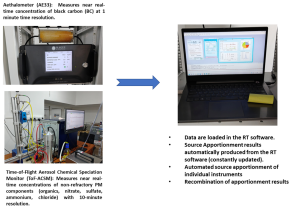Over the last decade, sensor-based monitoring using low-cost air quality sensors has been introduced to complement the air quality measurements carried out using in-situ reference-grade instruments and remote sensing and to identify hyperlocal hotspots across several cities worldwide. Since low-cost sensors are sensitive to meteorology, ambient pollutant concentrations and cross-sensitivity to other pollutants, these need to be evaluated and corrected before deployment in sites for monitoring the pollutants. Hence, the first India Sensor Evaluation and Training (Indi-SET) center was established in the Center for Study of Science, Technology, and Policy (CSTEP) campus in Bengaluru in December 2023. Since its establishment, the Indi-SET facility in Bengaluru has collocated 150+ multipollutant (particulate and gaseous) low-cost sensors with reference instruments to evaluate the performance or develop the correction models. The Indi-SET facility has evaluated the short-term and long-term performance of 60+ multipollutant low-cost air sensors from six different integrator brands commercially available in the Indian market and has currently partnered with Airparif France for the AIRLAB Microsensor challenge 2025 to evaluate 18 sensor manufacturers from 11 different countries, including India.
Indi-SET houses an online Air Quality Monitoring Station (AQMS) (Figure 3) equipped with various reference-grade instruments that monitor multiple air pollutants, including particulate matter (PM2.5, PM10), and key pollutant gases ozone (O3), carbon monoxide (CO), and nitrogen dioxide (NO2). Indi-SET also holds a time-of-flight Aerodyne Time-of-Flight Aerosol Chemical Speciation Monitor (ToF-ACSM), two Aethalometers (AethLabs microAeth MA300 and Magee Scientific AE33), PM sequential sampler (Metone Super SASS), and in the process of commissioning Xact 625i Ambient Continuous Multi-Metals Monitor. These sophisticated instrumentations are used to measure continuous near real-time chemical composition of non-refractory, refractory and elemental components of ambient PM2.5. Additionally, Indi-SET also has instruments for measuring aerosol number size distribution from 4 nm to 29.4 µm using various number size measuring instruments like Scanning Mobility Particle Sizer (SMPS) and FIDAS or EDM, along with an automatic weather station that measures temperature, relative humidity, ambient pressure, precipitation, wind speed and wind direction.
As India is known for its unique climatic conditions, diverse land use patterns, heterogeneous population and varying levels of pollution concentrations, it is insufficient to have a single sensor evaluation center in India to evaluate the performance of sensors in the Indian context. Hence, as part of this project, we will be partnering with different institutions in India to expand the Indi-SET facility beyond Bengaluru to cover contrasting weather patterns and pollution loads.

The National Clean Air Programme (NCAP) requires non-attainment cities to reduce PM₁₀ levels by 40% by 2025–26 (from 2019–20 levels) or bring them below the NAAQS limit of 60 µg/m³. To achieve this, identifying the key sources of pollution is essential for developing effective mitigation strategies. NCAP therefore mandates all 131 non-attainment cities to conduct source apportionment studies before preparing regional and city-level clean air plans. Real-time availability of source apportionment results can help policymakers take timely, evidence-based actions, for example, activating Graded Response Action Plans (GRAPs) during pollution spikes, and support the programme’s goal of a 15% increase in good air days (AQI < 200).
Traditionally, cities have relied on source apportionment approaches using laborious filter-based sampling of PM2.5 or PM10, followed by time-consuming laboratory analysis for determining the PM chemical composition. The resulting dataset is then analysed using source–receptor models such as the United Nations Environmental Protection Agency’s (EPA’s) Chemical Mass Balance (CMB) model, which requires prior knowledge of highly variable and not widely available local source profiles. The use of generic (e.g. EPA SPECIATE) source profiles can introduce significant error in the results.
The advanced instrumentation at Indi-SET facility at CSTEP, Bangalore overcome these challenges by using a combination of ToF-ACSM (for non-refractory- organics, nitrate, sulfate, ammonium and chloride), aethalometer (for refractory black carbon) and Xact (for trace elements) to perform complete chemical characterization of PM2.5 in near-real time with high time resolution. While NCAP guidelines focus on PM10, these advanced instruments (ToF-ACSM, AE33) primarily measure PM2.5 composition. However, organics, sulphate, nitrate, ammonium, chloride and black carbon, the major anthropogenic contributors, are largely confined to the PM2.5 fraction, meaning these instruments capture the dominant controllable portion of PM pollution. With the Xact monitor, equipped with a dual-cyclone inlet system (PM2.5 and PM10), bridges the gap by capturing coarse dust components that fall within the PM10 range. Thus, the combination of ToF-ACSM + AE33 + Xact provides a comprehensive coverage of the key anthropogenic components influencing PM10 concentrations relevant for NCAP targets.
Source apportionment is performed using advanced receptor modelling packages like PMF Evaluation Tool (PET) and Source Finder (SoFi) which do not require a-prior information of source profiles as in CMB model. A further advancement is the Source Finder Real-Time (SoFi-RT) package, which can process the ACSM, Xact, and AE33 data and perform the source apportionment in near real time. This combination of high-time-resolution instruments with a package such as SoFi-RT is often called real-time source apportionment (RTSA). The Air Quality Observations team at the Center for Study of Science, Technology and Policy (CSTEP) has been working on near-real-time source apportionment using SoFi-RT with ToF-ACSM and AE33 data (Figure 4), with plans underway to include the Xact monitor as well.
